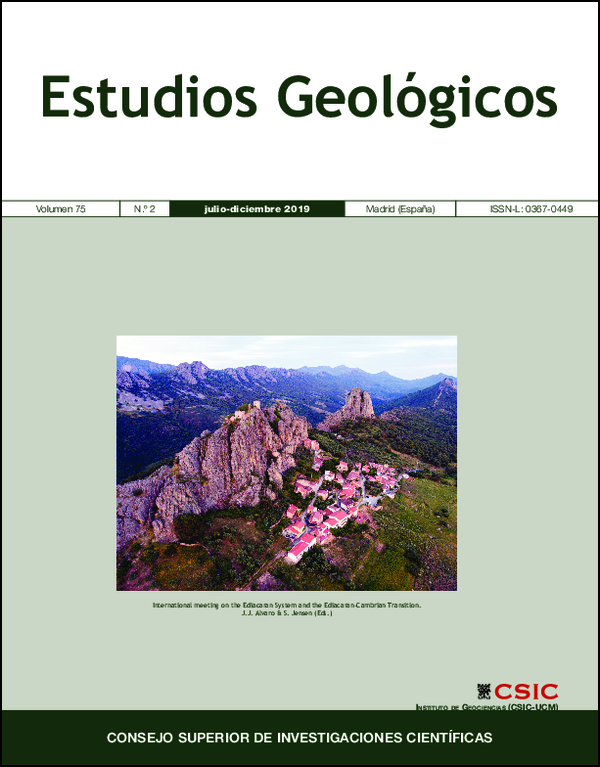Systematic revision of the oryctocephalid trilobite Protoryctocephalus arcticus Geyer & Peel, 2011 from the lower Cambrian (Stage 4) of Balang, South China
DOI:
https://doi.org/10.3989/egeol.43586.553Keywords:
Trilobites, Miaolingian, Biostratigraphy, Greenland, ChinaAbstract
The oryctocephalid trilobites from the traditional ‘lower-middle Cambrian’ represent key tools for international correlation. The trilobite zones in South China around the Cambrian Series 2-Miaolingian are made using oryctocephalids. One of the trilobite zones suggested is based on Protoryctocephalus arcticus. Protoryctocephalus from the Balang area in South China was described as Protoryctocephalus wuxunensis, also from the Cambrian Series 2 of South China. However, Protoryctocephalus from Balang shows different morphological features such as different glabellar shape, presence of a transglabellar S1 and more segments in the trunk. These features match with Protoryctocephalus arcticus from the Cambrian Series 2 of Greenland.
Downloads
References
Beecher, C.E. (1897). Outline of a natural classification of the trilobites. American Journal of Science (Series 4), 3: 89-106. https://doi.org/10.2475/ajs.s4-3.14.89
Esteve, J.; Zhao, Y. & Peng, J. (2017). Morphological assessment of the Cambrian trilobites Oryctocephalus indicus (Reed 1910) from China and Oryctocephalus 'reticulatus' (Lermontova 1940) from Siberia. Lethaia, 50: 175-193. https://doi.org/10.1111/let.12185
Esteve, J.; Zhao, Y.L.; Maté-González, M.A.; Gómez-Heras, M. & Peng, J. (2018). A new high-resolution 3-D quantitative method for analysing small morphological features: an example using a Cambrian trilobite. Scientific Reports, 8: 2868, https://doi.org/10.1038/s41598-018-21088-4 PMid:29434204 PMCid:PMC5809599
Geyer, G. & Peel, J.S.; (2011). The Henson Gletscher formation. North Greenland and itsbearing on the global Cambrian Series 2-3 boundary. Bulletin of Geosciences, 86: 465-534. https://doi.org/10.3140/bull.geosci.1252
Hupé, P. (1953). Contribution à l'étude des Trilobites du Maroc. 1. Faunes de Trilobites et zones paléontologiques du Cambrien inférieur de l'Anti-Atlas. Notes et Mémoires du Service Géologique du Maroc, 103: 41-333.
Kaesler, R.L. (ed.) (1997). Treatise on Invertebrate Paleontology. Part O. Arthropoda1. Trilobita, Revised. Geological Society of America, Boulder, and University of Kansas, Lawrence.
Lu, Y.H.; Chang, W.T.; Chien, Y.Y.; Chu, C.L.; Lin, H.L.; Zhou, Z.Y.; Qian, Y.; Zhang, S.G. & Yuan, J.L. (1974). Cambrian trilobites. In: Nanjing Institute of Geology and Palaoentology (ed.) Handbook of Stratigraphy and Palaeontology of southwest China. Science Press, Beijing, 82-107 [in Chinese with English summary].
Luo, X.X.; Zhao, Y.L. Peng, J.; Yang, Y. & Pan, Y.J. (2014). A preliminary study of Protoryctocephalus Chow (Zhow) in Lu et al. 1974B from the Cambrian "Tsinghsutung Foirmation" of Guizhou, China. Acta Palaoentologica Sinica, 53: 327-334 [in Chinese with English summary].
Yuan, J.L. & Esteve, J. (2015). The earliest species of Burlingia Walcott, 1908 (Trilobita) from South China: biostratigraphical and palaeogeographical significance. Geological Magazine, 152: 358-366. https://doi.org/10.1017/S0016756814000417
Yuan, J.L.; Zhao, Y.L.; Li, Y. & Huang, Y.Z. (2002). Trilobite fauna of the Kaili formation (uppermost Lower Cambrian-lower Middle Cambrian) from southeastern Guizhou, South China. Shanghai Science and Technology Press, Shanghai [in Chinese with English summary].
Zhao, Y.L.; Yuan, J.L.; Yang, X.L. & Esteve, J. (2015). Restudy of Ovatoryctocara Tchernysheva, 1962 from the Kaili Formation, Jianhe County, Guizhou, South China. Annales de Paléontologie, 101, 193-198. https://doi.org/10.1016/j.annpal.2015.06.001
Zhao, Y.L.; Yuan, J.L.; Esteve, J. & Peng, J. (2017). The oryctocephalid trilobite zonation across the Cambrian Series 2-Series 3 boundary at Balang, South China: a reappraisal. Lethaia, 50: 400-406. https://doi.org/10.1111/let.12227
Published
How to Cite
Issue
Section
License
Copyright (c) 2019 Consejo Superior de Investigaciones Científicas (CSIC)

This work is licensed under a Creative Commons Attribution 4.0 International License.
© CSIC. Manuscripts published in both the print and online versions of this journal are the property of the Consejo Superior de Investigaciones Científicas, and quoting this source is a requirement for any partial or full reproduction.
All contents of this electronic edition, except where otherwise noted, are distributed under a Creative Commons Attribution 4.0 International (CC BY 4.0) licence. You may read the basic information and the legal text of the licence. The indication of the CC BY 4.0 licence must be expressly stated in this way when necessary.
Self-archiving in repositories, personal webpages or similar, of any version other than the final version of the work produced by the publisher, is not allowed.















